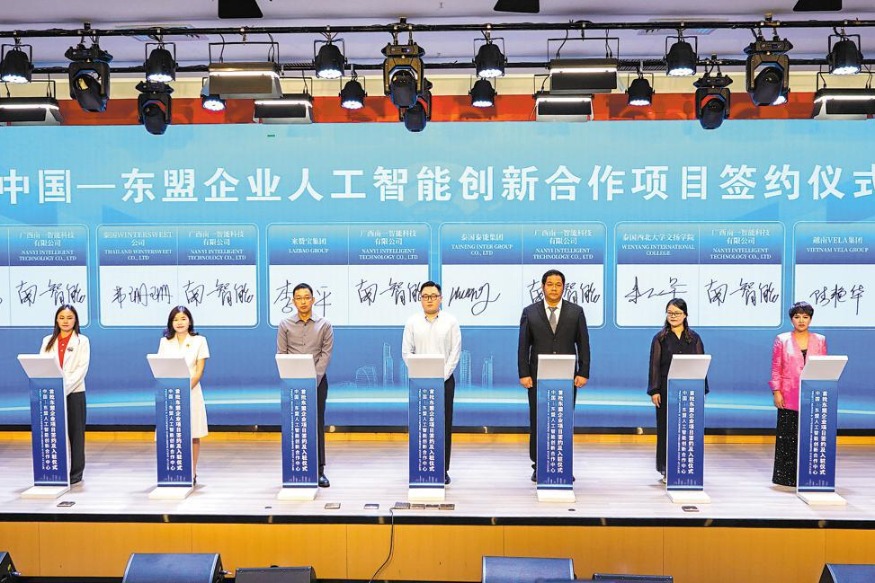RCEP can facilitate tripartite FTA


The Regional Comprehensive Economic Partnership agreement came into effect on Jan 1 for China, Japan, Australia, New Zealand, and six member states of the Association of Southeast Asian Nations. For the Republic of Korea, it will come into force on Feb 1. This, in earnest, marks the smooth launch of the world's largest free trade area.
Given that the RCEP will deepen China-Japan-ROK economic and trade cooperation, will the decade-long free trade area talks among the three countries achieve a major breakthrough?
The RCEP is not only the first free trade agreement which China, Japan and the ROK are signatories to, but also an important foundation for the establishment of a China-Japan-ROK free trade agreement (FTA) on tariff reduction, market access and regional supply chain adjustment.
Now that the RCEP has come into force, 86 to 88 percent of goods traded between China and Japan, and 83 percent of those traded between Japan and the ROK will soon be on zero tariffs. And the fact that China, Japan and the ROK are all members of the RCEP provides an integrated institutional framework for the three sides to carry out trilateral economic and trade cooperation, and advance higher-level trade arrangements in areas of origin, trade in services and e-commerce.
Apart from significantly lowering trade and investment barriers, the RCEP will also integrate the industrial, supply and value chains of China, Japan and the ROK due to more flexible cumulative rules of origin. According to projections, the RCEP will increase China's exports by 8 percent, Japan's by 5 percent and the ROK's by 8 percent.
Also, since the accumulated GDP of China, Japan and the ROK accounted for 82.44 percent of the total GDP of all RCEP members in 2020, it would be safe to say that China-Japan-ROK economic cooperation will have a major impact on the RCEP.
Therefore, the breakthroughs in China-Japan-ROK free trade agreement talks and the accelerated formation of a higher-level and broader trilateral cooperation mechanism will not only help consolidate the achievements of RCEP cooperation, but also help promote a new regional economic integration pattern.
China is not only the largest consumer market for Japan and the ROK, but also the largest investor in high-end manufacturing in the region. In fact, China is projected to overtake the United States in total retail sales of consumer goods before 2025.
Besides, with economic and social transformation and upgrading, there is huge room for the growth of services consumption in China-the proportion of Chinese people's services consumption is estimated to grow from about 45 percent in 2021 to about 60 percent by 2035, resulting in an additional consumption of trillions of dollars.
The projection should come as good news especially for the healthcare, cultural and entertainment, and information technology sectors of Japan and the ROK. With the transformation and upgrading of China's industrial and consumption structure, along with the continuing opening up of its services trade sector, China's service imports will likely continue growing rapidly once the COVID-19 pandemic is effectively contained.
Besides, China's institution-based opening-up will facilitate high-level economic and trade cooperation among China, Japan and the ROK. In particular, since China has applied to join the Comprehensive and Progressive Agreement for Trans-Pacific Partnership, and the ROK has started the process of joining it, the CPTPP, in the future, will help deepen high-level trade and economic cooperation among China, Japan and the ROK.
As for now, the three countries should make good use of tariff reduction and investment facilitation arrangements under the RCEP framework, by making efforts to shorten the transition period for tariff reduction, promoting the flow of goods and factors of production, and trilateral economic and trade development. Also, they should make full use of the more flexible rules of origin and work to build more resilient and dynamic industrial and supply chains under the RCEP framework while focusing on equipment and smart manufacturing.
More important, services trade may be a weak link in the RCEP and the China-Japan-ROK free trade agreement talks, yet it has the greatest potential for boosting economic and trade cooperation among the three sides. So the three sides should strive to make breakthroughs in liberalizing trilateral trade in services.
Under the RCEP framework, Japan and the ROK have introduced negative list management in cross-border service trade while China is expediting the process of moving from a positive list to a negative list. Therefore, China and Japan can first introduce free trade in services at the bilateral level, followed by China and the ROK. By doing so they can gradually make free service trade a trilateral affair.
The three countries should base their trilateral cooperation on the RCEP, enhance mutual trust while promoting high-level cooperation in specific areas, and realize the positive effects of the reinforcement between "smaller multilateral" cooperation and "broader multilateral" cooperation under the RCEP.
This will not only benefit the three countries, but also have a huge impact on regional economic and trade cooperation under the RCEP framework.
The views don't necessarily reflect those of China Daily.
The author is president of the China Institute for Reform and Development. This is an excerpt from a speech he delivered at the Eighth Dialogue on China-Japan-ROK Cooperation, which was jointly held by the China Institute for Reform and Development and other think tanks on Jan 17.


































